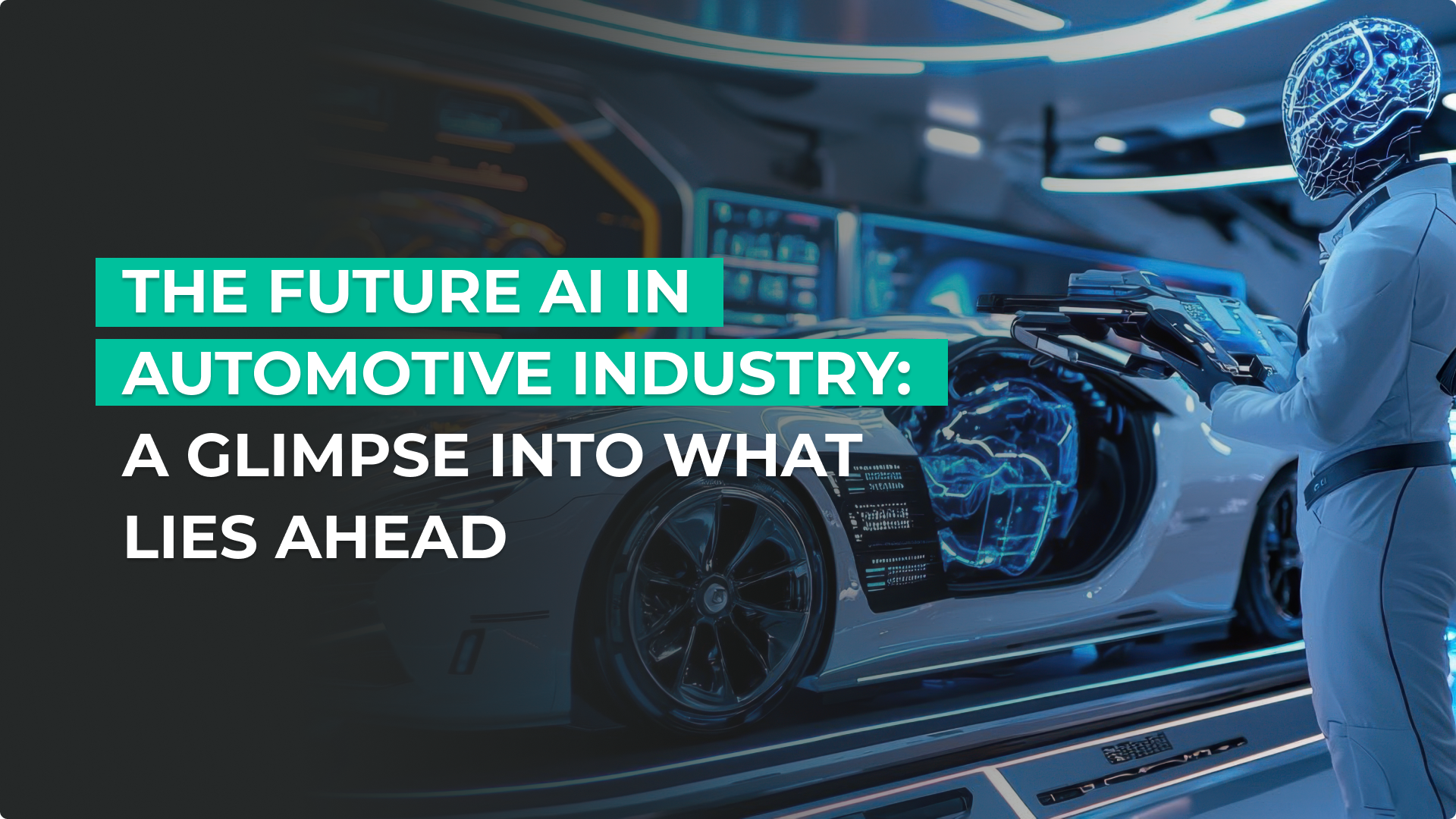Artificial intelligence (AI) has transformed the automotive industry. Modern vehicles are not only mechanical machines. They are smart, connected, and decision makers. As we enter 2026 and beyond, the integration of AI in vehicles will take many folds. From self-driving cars, intelligent safety systems, customized in-car experience to predictive maintenance. There are new levels of automation in how vehicles are designed, manufactured, repaired and used.
The global automotive artificial intelligence (AI) market size is expected to reach USD 48.59 billion by 2034. As of today, North America has the largest market share of 36.8% in 2023. This is due to major leaders investing in research and development of AI tools. Also, an increasing potential demand for driverless vehicles and autonomous safety capabilities.
The Next Wave of AI: Transforming Core Automotive Functions
The application of AI in the automotive industry is not limited to research. It is now penetrating every core functional aspect of the industry. From factories that manufacture smarter cars to connected vehicles and personalized customer experiences. The next generation of AI is redefining the way cars are manufactured, driven, and serviced.
Unlock powerful tools to manage your shop. Get the full AutoLeap experience today.
Smart Factory Automation
Smart factories use AI and robotics for vehicle manufacturing. Intelligent robots are quick to learn the process and help reduce downtime. AI algorithms look into production data in real-time. They alert for unusual patterns that can lead to bottlenecks or failures.
Real-time production adjustments ensure there are no operational delays. Manufacturing processes are optimized, and wastage costs are reduced. IoT devices and sensors communicate real-time to sync tasks. This helps fasten production and minimize costs.
A 2024 McKinsey report says manufacturers using AI for predictive maintenance reduced downtime by 20%.
Supply Chain and Logistics
Difficult assembly tasks can be managed by robots with AI vision systems and sensors. They are able to complete these tasks with more precision than human workers. They can correct small deviations that help reduce waste and maintain quality.
AI-powered quality control systems monitor the production process and quickly identify potential errors. This helps in quick fixes and continuous production with high quality.
Driver safety and AI assistance
AI-powered crash detection and advanced braking technologies have reduced manual errors and risks. This is because most vehicles have machine learning algorithms. They analyze driving patterns and environmental conditions that help drivers avoid potential threats.
Automatic brakes cut down on rear-end collisions by about 40%. Forward collision warning systems cut down on those kinds of crashes by 23%.
AI-powered preventative maintenance has increased vehicle reliability. The real-time monitoring detects issues early and prevents sudden breakdowns. The issue is flagged early, which also saves costly repairs. Overall, the vehicle remains in good condition for a longer time.
Here are a few examples of how it works:
- Engine Malfunction Prediction: AI sees inconsistent combustion patterns. This means engine misfires or other issues.
- Brake System Analysis: Sensors see abnormal wear or overheating. It’s time to replace brake pads.
- Battery Life Estimation: AI sees usage patterns and knows when to replace.
Connected Cars and Autonomous Vehicles
AI voice technologies have made driving easier in connected cars. AI uses natural language processing that allows drivers to ask for help. The new version connects local devices with cloud services, it is for faster and accurate communication.
Personalized driver assistants adapt to driver’s preferences. They learn about users’ driving habits and make recommendations accordingly. They can make phone calls, regulate temperature, or find parking.
AI is integrated into driver assistance systems in emergency braking and lane-keeping. Improving vehicle safety by warning drivers of imminent dangers. By reducing reliance on conventional touchscreen use, voice control helps minimize instances. This is possible when drivers are forced to look away from the road and take their hands off the steering wheel.
Through voice, drivers interact with the navigation system and car features. This hands-free use is definitely an enhancement for road safety. It allows drivers to remain focused on driving. AI voice systems give quick alerts of traffic and danger. A vital tool in ensuring the safety of drivers and rerouting them to an efficient route.
Autonomous vehicles use remote-sensing technologies such as radar, GPS, cameras and lidar. These technologies create a 3-D map of the environment. It includes street infrastructure, traffic lights, and road signs. These environments help them process and make safe decisions. Some of which are steering adjustment, cruising speed and braking.
The continuing role of ADAS in vehicles
Advanced Driver Assistance Systems (ADAS) use sensors for vehicle safety. When an object has been detected that might collide. These systems send warnings to the driver and automatically reduce speed before any collision occurs. Also, the lane departure warning system analyzes the vehicle’s position about the lane markings.
The Society of Automotive Engineers have six levels of autonomous driving in vehicles:

Customer Experience and Service
AI marketing automation is able to run campaigns that are highly targeted. Backed by data which ensures better ROI and enhances customer relationships. Your automotive business can gain a higher conversion rate. How? AI suggesting automobiles, upgrades, or services. All that closely serve the individual needs of its customers.
AI-Powered Customer Service Solutions
Many auto shops struggle to keep track of missed calls. This can lead to reduced revenue and disappointment from potential and existing customers. This is because most of the callers will not leave a voicemail and sometimes never even call back. Result? Unanswered calls might cost hundreds of dollars in potential business.
AI Customer Service uses AI tools to improve customer support. They use natural language learning (NLU) to answer customer calls, understand simple customer queries, and record conversations.
AutoLeap AIR—Your go-to AI receptionist
AutoLeap AIR is the best solution for auto shops looking to transition into AI.
An AI receptionist is available 24/7 to take customer calls in a natural, human-like voice. It has the ability to answer repetitive inquiries, fetch existing customer data, and even manage appointments. All of this while being integrated with your shop management system.
Your customers get quick, accurate, and 24/7 support. The customer satisfaction rises that can eventually lead to potential revenues for your auto shop business.
Here’s how AutoLeap AIR helps you achieve this:
- Price Guide: AutoLeap AIR can reference shop-specific pricing. It can answer common price questions such as “How much is an oil change?”
- Hours of Operation: The customers are unaware of your shop’s daily hours or holiday days, and they call to confirm. In these cases, AutoLeap AIR can provide accurate availability information.
- Agent Call Forwarding: It also helps connect callers with auto technicians or managers during business hours for any complex request, such as asking about a specific repair.
- Customized Location Instructions: First-time visitors want to know your shop whereabouts. AutoLeap AIR can easily answer with “We’re right next to the grocery store on Main Street.”
- SuperCallerID: Returning customers need not repeat their name and email. AIR already knows who the caller is and engages them in a smoother conversation.
These features combine to ensure seamless and professional handling of every call. This means more captured leads, efficient work, and a better customer experience for shop owners, all without placing additional burdens on their staff.
Sustainability & EV Integration
Traditional battery management systems (BMS) faced challenges. Inaccurate battery state of charge, and inability to know when battery might fail are a few. AI in BMS can help overcome this. The use of machine learning for accurate battery charging. DL algorithms for predictive maintenance to enhance lifespan. AI-driven optimization to predict failures and other risks.
The Business of AI: Market Trends and Future Projections
Automakers, large technology companies, and start-ups are investing in the AI niche. There are partnerships, generative AI breakthroughs, and evolving automotive trends. All just to lay the foundation for an AI-powered future worth billions by 2030.
Investment Patterns and Market Growth
As per the Next Move Strategy Consulting report, the global automotive intelligence market is expected to grow from 2019-2030. While the market was sized at some 2.5 billion U.S. dollars in 2019, it is likely to reach the size of around 74.5 billion U.S. dollars in 2030.

The automotive AI market share in North America is increasing to around 33%. This is because of the interest in self-driving cars. Also, safer and more efficient transportation. These factors led automakers to make heavy investments in AI-based technologies.
Key Players and Strategic Partnerships
Volkswagen Group is planning to invest one billion euros in artificial intelligence (AI). They aim to develop an AI engineering environment. It will be used for virtual testing and component simulations. They also want to benefit from the factory cloud to optimize manufacturing processes.
Similarly, Toyota intends to invest ten million dollars in AI and EVs. Another startup, Wayve, is working on the next generation of AI-powered vehicles. They will develop and launch the first AI products for OEM manufacturers.
Cantena-X will be the first open platform for the automotive sector. It will exchange data between manufacturers, suppliers and technology providers. The parties interested in this project are Volkswagen, BMW, BASF, Mercedes-Benz, and T-Systems.
The Rise of Generative AI
The automotive industry has adopted generative AI for operational efficiency. AI helps in designing vehicle parts faster by rapid prototyping and optimizing components. This has replaced the team of engineers that requires months to design. This results in reduced chances of manual errors. For example, an inspection system already detects micro-defects. These can be missed by human checks.
Automated decision-making has improved vehicle inventory management. AI in vehicles can easily predict which parts need to be replaced. Then, reorders inventory automatically. This results in operational efficiency gains and cost savings.
It is difficult to manage a supply chain with thousands of suppliers and parts. What if a part replacement is requested by a customer? But the part is out of stock. Result? Customer dissatisfaction.
The use of AI in supply chain optimization has reduced these challenges significantly. Machine learning keeps track of historical data on demand and inventory levels. The data is then used to take quick actions and optimize supply chain processes.
Demand forecasting is aided by machine-learning algorithms. It is now 85% more accurate than traditional statistical modeling. This helps manufacturers to align production with market fluctuations and reduce overproduction.
IoT technology in automotive inventory management will analyze real-time data and lower the carrying costs of inventory up to 25%. From timely restocking routines, dynamic safety stock optimization, to warehouse automation, it can take up a variety of operations for automotive businesses.
Demand forecasting is aided by machine-learning algorithms. It is now 85% more accurate than traditional statistical modeling. This helps manufacturers to align production with market fluctuations and reduce overproduction.
IoT technology in automotive inventory management will analyze real-time data and lower the carrying costs of inventory up to 25%. From timely restocking routines, dynamic safety stock optimization, to warehouse automation, it can take up a variety of operations for automotive businesses.
Regulatory and Ethical Landscape
Most critical is regulating AI in the automotive industry. There are safety, transparency, and accountability concerns during the design and implementation of vehicles.
The National Highway Traffic Safety Administration (NHTSA) in the USA issues guidelines for autonomous vehicle development. Their aim is to prevent road dangers associated with the overwhelming presence of self-driving cars.
ISO 26262 is for automotive safety. It ensures that risk management processes are adhered to during development. UL 4600 assesses the safety of products in the autonomous realm. It provides a holistic framework for the safe deployment and operation of AI systems.
Preparing for an AI-Driven Future: Skills and Workforce Evolution
The rising AI competition has transformed the automotive industry. This necessitates up-skilling labor across the spectrum. While the conventional job description of mechanic technicians is still valid. Data scientists and AI/ML engineers are in high demand. Their skills will be used from predictive analytics to creating autonomous driving algorithms.
AI is disrupting the auto shop even in day-to-day operations. For instance, AI diagnostic systems are detecting issues much faster. This allows technicians to spend less time troubleshooting and focus on solutions. These technologies do not aim to replace human expertise. They help in completing the tasks more efficiently and accurately. As a result, enabling service providers to offer a quicker service of higher quality.
Most auto repair shop owners are already beginning to adapt. Some have started investing in training programs. The training focuses on technical knowledge integrated with AI literacy. Some shops use AI-powered platforms, such as AutoLeap AIR. It is to manage appointments and customer inquiries.
Others encourage their auto technicians to learn about digital diagnostics. This way, they generate a workforce that expresses no resistance to AI. They learn to work in tandem with it. They help auto businesses thrive in an AI-powered industry.
Looking Beyond 2030: The Long-Term Vision for Automotive AI
Beyond 2030, automotive AI will gradually evolve from safety and efficiency purposes. They will shift focus to designing completely new mobility experiences. Cars will evolve into hyper-personalized spaces. This is where AI can recall individual driver preferences in anything. From seat positioning, cabin temperature to curated entertainment options. Thereby, recreating vehicles as extensions of a personal lifestyle.
Mobility-as-a-Service (MaaS) will begin to challenge the very foundation of car ownership. Fleets of autonomous, AI-enabled vehicles will become more accessible to passengers on demand.
Auto Repair Shops Adapt AI Tools
- Diagnostic tools: This tool can fetch data from a vehicle’s computer. Use data with information added by the technician to analyze and highlight issues.
- Scheduling software: Tells how long it takes to complete each job and when techs and equipment are available. They can also update appointments by pushing them back. If a job takes longer than expected, then pick another time altogether.
- Data Analytics: They help you look into possible bottlenecks in operations. They can highlight repairs that are taking longer and report it to the auto repair manager. This way you can look into possible causes and improve service.
Conclusion
The potential benefits of AI in the automotive industry are commendable. Reducing congestion, decreasing costs for consumers, and creating smarter and more connected transportation ecosystems.
AI could be a helpful asset in saving shops’ time and resources. From efficiency in both inventory management and customer support to predictive maintenance, there is nothing it can’t do.
Do you want to step into the future of automotive repair? AutoLeap, a shop management solution is your hero. It’s a smart solution that can transform your auto repair business by automating processes and improving operational efficiency.
FAQs
AI is no longer just a tool. The advanced and smart capabilities make it a core part of the driving experience. From ADAS, predicting failures to strengthening supply chains.
AI is taking over the role of customer support. A chatbot available 24/7, scheduling appointments. Also, giving personalized experiences to retain customers.
AI tools increase driver safety. However, customers still prefer semi-autonomous vehicles. This is to have control in cases where AI isn’t reliable enough.








